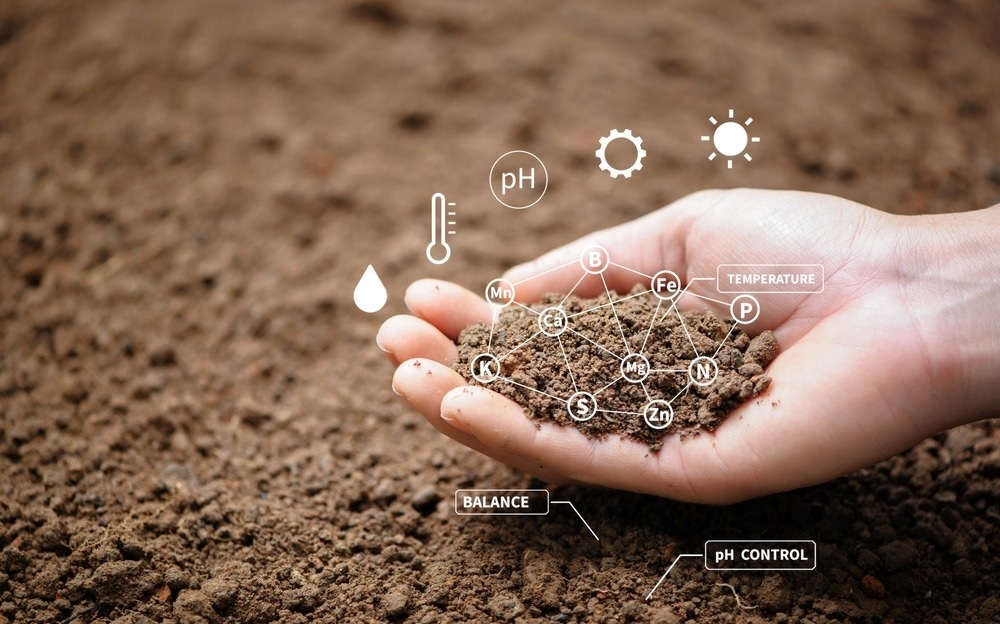The soil Humeome refers to the various organic molecules that make up humus, a soil substance consisting of decayed plant and animal remains. Characterization of the soil Humeome provides insight into the dynamics involved in its contributions to vital soil functions and the ways in which land management decisions impact these functions.

Soil. Image Credit: Piyaset/Shutterstock.com
Introducing the Soil Humeome
Soil organic matter (SOM) is the proportion of soil that is composed of plant and animal remains in various stages of decomposition. Around 80% of SOM is humus, a stable, dark material formed from fully decomposed organic matter.
The molecular composition of humus, also known as the soil Humeome, has traditionally been investigated through alkaline extraction, in which humic molecules are extracted from the soil using an alkali and subsequently categorized based on their solubility in water.
This method led to the emergence of three different categories of stable, high molecular weight humic substances: fulvic acid, humic acid, and humin. However, these compounds are now thought to be unrepresentative of the original arrangement of molecules that is present in humus prior to extraction.
Recent advancements in spectroscopic analysis techniques have allowed scientists to study the soil Humeome in greater detail, and as a result, humic substances are now viewed as supramolecular associations of diverse organic molecules with low molecular masses, rather than large, complex macromolecules.
These relatively small molecules are self-assembled by weak, non-covalent forces, such as hydrogen bonds and hydrophobic intermolecular interactions, which collect the molecules together into apparently large molecules.
Identification of these small humic molecules can be achieved through a process called Humeomics, which involves stepwise separation of the molecules by the progressive breaking of inter- and intra-molecular interactions, without breaking any carbon-carbon bonds. The separated molecules can then be identified using advanced analytical instruments.
Some of the humic molecules that have been identified by Humeomics include fatty acids, dicarboxylic acids, phenolic acids, linear alcohols, amino acids, and carbohydrates.
How does the Soil Humeome Contribute to Soil Functioning?
The soil Humeome is essential to many of the physical, chemical, and biological processes that occur within the soil. Not only does it play an important role in the global carbon cycle by sequestering large amounts of carbon, thereby helping to counter global warming, but it also helps to facilitate plant growth.
Humic molecules aid in the growth of plants by forming soluble complexes with micronutrients such as zinc, copper, and iron, which increases the bioavailability of these nutrients to plants, and also improves plant nutrition by encouraging nutrient uptake by plant roots.
It also has a large influence on the physical properties of soil, as humic molecules encourage an association between fine soil particles, leading to the formation of larger soil aggregates.
This aggregate formation is facilitated by the progressive accumulation of hydrophobic humic molecules, which create a hydrophobic environment within the soil that is impermeable to aqueous solution. This improves the structure of the soil, which in turn reduces its susceptibility to erosion, and aids in the movement of water through the soil and root growth.
As well as this, humic substances act as a buffer that controls the fate of certain pollutants in the environment. Humic molecules can incorporate and retain organic pollutants within the hydrophobic domains of humic suprastructures and can form complexes with heavy metals to counteract the negative effects these metals may have on the biological properties of soil.

Soil conditions. Image Credit: Deemerwha studio/Shutterstock
How does Land Management Impact the Soil Humeome?
As the molecular composition of the soil Humeome plays a significant role in soil functioning, it is important to consider the impact of land management decisions on the soil Humeome in order to assess the consequences of these decisions for soil health.
A study conducted by Drosos and Piccolo in 2019 investigated the Humeome of an agricultural soil after one year and three years of maize cultivation under continuous conventional tillage. They found a substantial change in the molecular composition of the soil Humeome resulting from conventional tillage.
Prolonged tillage resulted in the loss of small nitrogen-rich compounds as well as the progressive loss of hydrophobic molecules within the soil and an associated increase in organic matter decomposition and reduction in soil stability. These results explain the observed decline in the quality of maize crops planted in soil that has been subjected to three years of conventional tillage.
They also found that the covalent binding of iron with humic compounds led to the stabilization of these compounds. As such, the formation of organo-iron bonds proved to be a major mechanism through which soil organic carbon and nitrogenated compounds persisted in the soil despite tillage.
Another study used Humeomics to characterize the soil Humeome under long-term maize monoculture compared to under a maize-leguminous crop rotation. They found that there was a significant loss of hydrophobic compounds, such as fatty acids and long-chain esters, associated with the monoculture, which caused the soil to become more physically and chemically fragile.
This research shows that land management has a significant effect on the composition of the soil Humeome, consequently altering its dynamics and affecting soil quality.
Understanding the impact of poor practices on our soils is crucial if we are to maintain healthy soils, especially when demands on agricultural production are ever-increasing. As such, it is essential that we continue to utilize Humeomics to further improve our understanding of soil Humeome dynamics.
Sources:
- Baveye, P.C., and Wander, M. (2019). The (bio) chemistry of soil humus and humic substances: why is the “new view” still considered novel after more than 80 years? Frontiers in Environmental Science, 7, p.27. https://doi.org/10.3389/fenvs.2019.00027
- Sutton, R. and Sposito, G. (2005). Molecular structure in soil humic substances: the new view. Environmental Science & Technology, 39(23), pp.9009-9015. https://doi.org/10.1021/es050778q
- Drosos, M. and Piccolo, A. (2018). The molecular dynamics of soil humus as a function of tillage. Land Degradation & Development, 29(6), pp.1792-1805. https://doi.org/10.1002/ldr.2989
- Savarese, C., Xiong, L., Drosos, M., Vitaglione, P., Scopa, A. and Piccolo, A. (2022). The impact of long-term field experiments under different cropping systems on the molecular dynamics and stability of the soil Humeome. Agriculture, Ecosystems & Environment, 331, p.107928. https://doi.org/10.1016/j.agee.2022.107928
- Piccolo, A., Spaccini, R., Savy, D., Drosos, M. and Cozzolino, V. (2019). The soil humeome: chemical structure, functions and technological perspectives. In Sustainable agrochemistry (pp. 183-222). Springer, Cham.
Further Reading
Last Updated: Oct 7, 2022